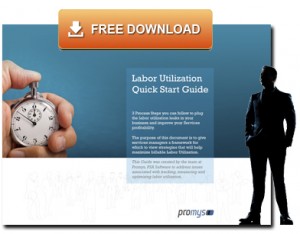Achieve improved labor utilization by fixing labor utilization leaks
 Two thirds of professional services businesses target 80% billable labor utilization but less than 25% actually achieve that target. On the surface, it sounds simple; maximizing billable utilization should just be a matter of:
Two thirds of professional services businesses target 80% billable labor utilization but less than 25% actually achieve that target. On the surface, it sounds simple; maximizing billable utilization should just be a matter of:
- Selling enough to keep your service techs busy
- Tracking direct and indirect time accurately
- Identifying any unnecessary indirect time and eliminating it
So, why do more than 75% of IT solution providers not achieve their target billable utilization?
In organizations that miss their billable utilization targets, there are typically three areas that consistently contribute to labor utilization leaks. These areas should be examined and solutions implemented in order to achieve optimal labor utilization.
1) Not enough planning runway
The problem with many service organizations is that they’re constantly fighting resource allocation fires. Many service departments don’t even know what detailed service fulfillment resources will be required for a project until after an order gets booked; then it’s a fire drill:
- pull resources off other projects,
- schedule unplanned overtime,
- transition the work to a lower margin subcontractor, or
- make a quick new hire who will take time to ramp up and will not be fully productive right away.
All of this contributes to non-billable time as resources inefficiently jump back and forth between projects, work unscheduled overtime where the client will be billed at the regular rate, hand off work to a subcontractor at lower than expected margin, spend time training the new guy, or the new guy taking longer to complete tasks before they’re fully ramped up.
Solution:
Ideally, the organization would have access to a detailed labor forecast, by specialized resource type (design, PM, installation, training). That labor forecast would be driven by each new quote revision so that every time a quote revision with a revised labor estimate is issued, the labor forecast would be updated in real-time. This would allow the services manager to get real-time visibility 30-60-90 days from now into exactly what kinds of resources they’re going to need and in what time frame. This would significantly reduce pushing & pulling resources between projects, unscheduled overtime, and unplanned subcontracting. This would also allow more proactive hiring including appropriate ramp up time.
This approach also requires a labor resource forecast in hours (not in dollars; a labor forecast in dollars is almost completely useless for real world labor planning purposes) and by specialization, rather than from a single generic resource pool of hours.
2) Not comparing detailed estimates to actuals
Most services organizations track overall estimated project implementation margin to actual project services margin. Very few actually know if they were over or under by detailed resource type – design hours, PM hours, installation or training hours.
This makes it very difficult to leverage any project services lessons learned back into the quoting process. So, even if the overall project target margins are achieved, billable utilization for one group may be achieved at the expense of another group (too many hours allocated for design, not enough for training).
The other side of that coin that is often overlooked is, in addition to making sure that estimated hours quoted are more consistently aligned with actual hours required for delivery, if project managers had the ability to compare detailed services estimates and actuals by specialized resource type, they could also notify the sales team where they were overbidding in certain areas (as well as avoiding under bidding in others). This would allow the sales team to be more aggressive with services pricing in certain areas at acceptable margins in order to win more business.
Solution:
The best way to handle this area would be to not to just track overall project services cost against budget performance but to also compare over or under at the detailed level – by specialized resource type. This would ensure that an accurate estimate was being provided for each task type, so that all resources had realistic targets between the work assigned and how long that work is actually going to take. This approach would significantly contribute to more uniform billable utilization across the organization.
3) Identifying required training
Most services organizations can identify resources that consistently have more actual hours than billable hours overall. Very few companies can actually tell if an individual resource does fine with some tasks, but struggles with others. This would be an indication that the individual resource might require some additional training in the areas where they’re struggling. Just like at the project level, this is typically because that resource is being evaluated at the summary level, not at the detail level.
This is also compounded by the fact that many organizations don’t have a standard metric for how long a task should take by a competent resource. So, a highly skilled resources might complete a task in 4 hours but it might take 6 hours for a lesser skilled resource. However, the task is always quoted at 4 hours. This isn’t the lesser skilled resource’s fault from a billable utilization perspective, it’s the organizations fault for scheduling them to those tasks and not consistently measuring their performance to identify the areas where they need more training.
Solution:
The organization should have a standard “complete time” for most task types. That standard time should be conveyed along with the services work order to that individual. The actual time should be automatically compared to the standard. Regular reports should be run on a pay period or monthly basis to help identify specific task types where the actuals consistently run past the standard.
This will make it very easy to develop some targeted training for that employee and could also be conveyed to the scheduler to avoid assigning that particular work type to that individual until they have completed more training in this area.
Better billable labor utilization by implementing solutions to 3 key areas
 At the end of the day, the reasons for missing billable labor utilization targets are pretty simple and pretty consistent. A fire drill is an inefficient way to allocate resources; over or under estimating cannot be corrected because it’s not being identified at a detailed enough level to be actionable. Also, tasks are taking longer than planned, but those specific tasks are not being identified at the individual employee level. If they were, resources could receive more training or be aligned with tasks that they can complete on time.
At the end of the day, the reasons for missing billable labor utilization targets are pretty simple and pretty consistent. A fire drill is an inefficient way to allocate resources; over or under estimating cannot be corrected because it’s not being identified at a detailed enough level to be actionable. Also, tasks are taking longer than planned, but those specific tasks are not being identified at the individual employee level. If they were, resources could receive more training or be aligned with tasks that they can complete on time.
By focusing on these 3 areas, you can achieve better billable labor utilization and become one of the 25% of businesses that consistently hit their billable utilization targets.
If you’d like more information on other Labor Utilization best practices, download the PROMYS Labor Utilization Guide.


